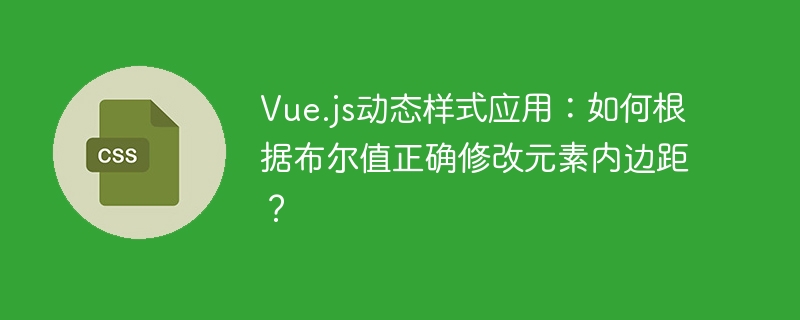 Web Front-end
Web Front-end
 CSS Tutorial
CSS Tutorial
 Vue.js dynamic style application: How to correctly modify element margins based on boolean values?
Vue.js dynamic style application: How to correctly modify element margins based on boolean values?
Vue.js dynamic style application: How to correctly modify element margins based on boolean values?

Vue.js dynamic style: cleverly use CSS selector to solve the problem of margin modification
In Vue.js development, dynamic adjustment of element style is a common requirement. This article will solve a problem about dynamically modifying element margins based on boolean values.
Problem description:
The developer tries to control the element's margins by binding the dynamic class name active . When the boolean iscollapse changes, the active class name should be added or removed, thereby changing padding-left of the element. However, the initial CSS code is invalid.
Code snippet:
Vue component code:
<div :class="{ active: iscollapse }" class="content">
<myheader :iscollapse="!iscollapse"></myheader>
</div>
data() {
return {
iscollapse: false
};
},
methods: {
changemenu() {
this.iscollapse = !this.iscollapse;
}
}Invalid initial CSS code:
.content {
padding-left: 200px;
.active {
padding-left: 65px;
}
}Problem analysis:
The problem is the use of CSS selector. The initial code uses the descendant selector .content .active , which requires that .active class must be a child element of .content to take effect. In fact, the active class directly acts on the .content element.
Solution:
The correct CSS selector should be a combination .content.active , ensuring that the style is applied only if .content element has active classes at the same time.
Correct CSS code:
.content {
padding-left: 200px;
}
.content.active {
padding-left: 65px;
}Or, it's easier to use Sass:
.content {
padding-left: 200px;
&.active {
padding-left: 65px;
}
} The Sass code is equivalent to the above CSS code after compilation. Both ensure that padding-left: 65px style is applied only when the .content element has active classes at the same time, solving the problem of style failure caused by descendant selectors in the initial code.
The above is the detailed content of Vue.js dynamic style application: How to correctly modify element margins based on boolean values?. For more information, please follow other related articles on the PHP Chinese website!

Hot AI Tools

Undresser.AI Undress
AI-powered app for creating realistic nude photos

AI Clothes Remover
Online AI tool for removing clothes from photos.

Undress AI Tool
Undress images for free

Clothoff.io
AI clothes remover

AI Hentai Generator
Generate AI Hentai for free.

Hot Article

Hot Tools

Notepad++7.3.1
Easy-to-use and free code editor

SublimeText3 Chinese version
Chinese version, very easy to use

Zend Studio 13.0.1
Powerful PHP integrated development environment

Dreamweaver CS6
Visual web development tools

SublimeText3 Mac version
God-level code editing software (SublimeText3)

Hot Topics
 1382
1382
 52
52
 How to add functions to buttons for vue
Apr 08, 2025 am 08:51 AM
How to add functions to buttons for vue
Apr 08, 2025 am 08:51 AM
You can add a function to the Vue button by binding the button in the HTML template to a method. Define the method and write function logic in the Vue instance.
 The Roles of HTML, CSS, and JavaScript: Core Responsibilities
Apr 08, 2025 pm 07:05 PM
The Roles of HTML, CSS, and JavaScript: Core Responsibilities
Apr 08, 2025 pm 07:05 PM
HTML defines the web structure, CSS is responsible for style and layout, and JavaScript gives dynamic interaction. The three perform their duties in web development and jointly build a colorful website.
 Understanding HTML, CSS, and JavaScript: A Beginner's Guide
Apr 12, 2025 am 12:02 AM
Understanding HTML, CSS, and JavaScript: A Beginner's Guide
Apr 12, 2025 am 12:02 AM
WebdevelopmentreliesonHTML,CSS,andJavaScript:1)HTMLstructurescontent,2)CSSstylesit,and3)JavaScriptaddsinteractivity,formingthebasisofmodernwebexperiences.
 How to use function intercept vue
Apr 08, 2025 am 06:51 AM
How to use function intercept vue
Apr 08, 2025 am 06:51 AM
Function interception in Vue is a technique used to limit the number of times a function is called within a specified time period and prevent performance problems. The implementation method is: import the lodash library: import { debounce } from 'lodash'; Use the debounce function to create an intercept function: const debouncedFunction = debounce(() => { / Logical / }, 500); Call the intercept function, and the control function is called at most once in 500 milliseconds.
 How to pass parameters for vue function
Apr 08, 2025 am 07:36 AM
How to pass parameters for vue function
Apr 08, 2025 am 07:36 AM
There are two main ways to pass parameters to Vue.js functions: pass data using slots or bind a function with bind, and provide parameters: pass parameters using slots: pass data in component templates, accessed within components and used as parameters of the function. Pass parameters using bind binding: bind function in Vue.js instance and provide function parameters.
 How to jump a tag to vue
Apr 08, 2025 am 09:24 AM
How to jump a tag to vue
Apr 08, 2025 am 09:24 AM
The methods to implement the jump of a tag in Vue include: using the a tag in the HTML template to specify the href attribute. Use the router-link component of Vue routing. Use this.$router.push() method in JavaScript. Parameters can be passed through the query parameter and routes are configured in the router options for dynamic jumps.
 How to jump to the div of vue
Apr 08, 2025 am 09:18 AM
How to jump to the div of vue
Apr 08, 2025 am 09:18 AM
There are two ways to jump div elements in Vue: use Vue Router and add router-link component. Add the @click event listener and call this.$router.push() method to jump.
 How to use vue pagination
Apr 08, 2025 am 06:45 AM
How to use vue pagination
Apr 08, 2025 am 06:45 AM
Pagination is a technology that splits large data sets into small pages to improve performance and user experience. In Vue, you can use the following built-in method to paging: Calculate the total number of pages: totalPages() traversal page number: v-for directive to set the current page: currentPage Get the current page data: currentPageData()



